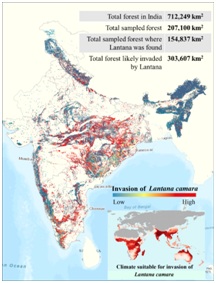

Context
Recently, Centre for Social and Environmental Innovation (CSEI) launched Gasification, a lantana-focused initiative.
About
About Lantana camara:
- Lantana camara was first introduced in 1807, had spread to wildlife reserves, river banks and the Project Tiger areas where it had obliterated native grass and reduced biodiversity.
- Lantana (Lantana camara) has become one of the world’s most invasive weeds.
- It competes with native plants for space and resources, and also alters the nutrient cycle in the soil.
- This invasion has resulted in the scarcity of native forage plants for wild herbivores.
- Lantana occupies 154,000 sq.km forests (more than 40% by area) in India’s tiger range.
- Among forests, Shivalik Hills in the North, fragmented deciduous forests of Central India, and Southern western Ghats are worst hit by its invasion.


|
Invasive Species:
|
The lantana gasification trial:
- CSEI-ATREE teamed up with BioTherm to explore the possibility of using lantana as the fuel in a gasifier.
- The sun-dried lantana wood chips were placed in a gasifier of 50 kg per hour capacity for eight hours.
- This process generated 1.2 million Kcal (kilocalories) of energy, and produced a blue flame indicating that the gas produced was clean and devoid of any particulate matter or tar.
- The eight-hour trial also produced 30 kg of biochar from the 400 kg of lantana gasified.

